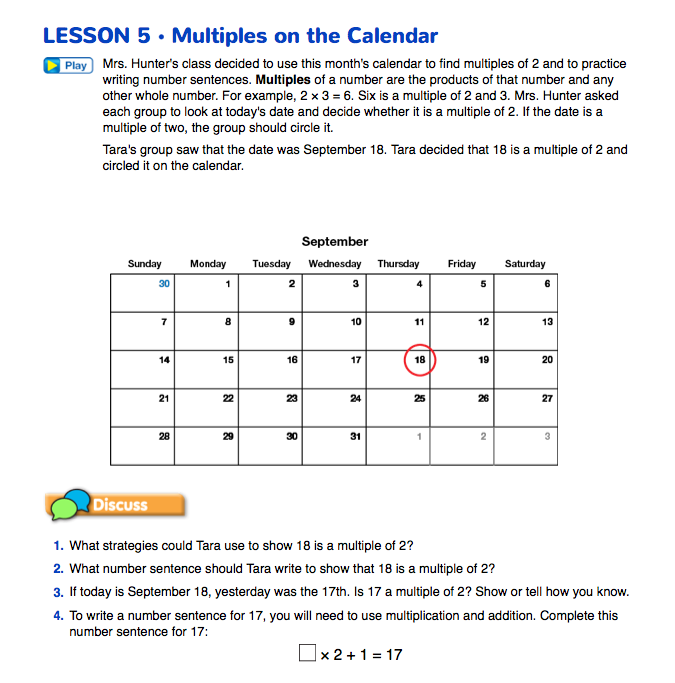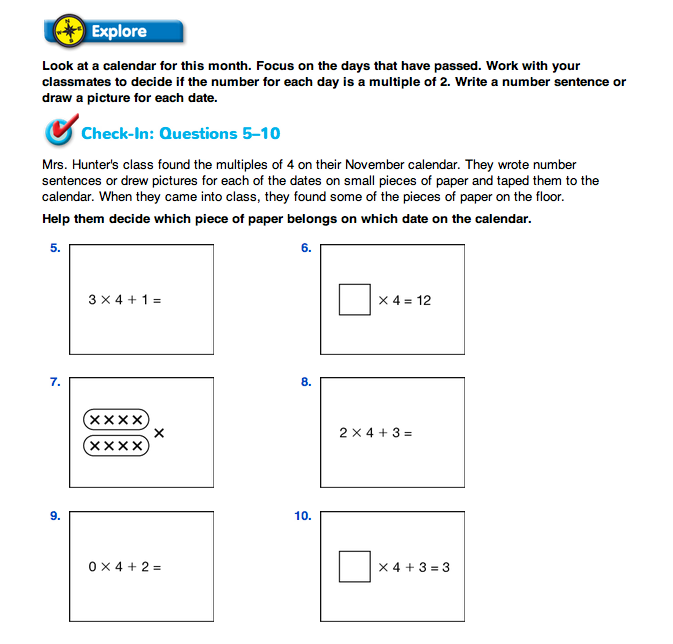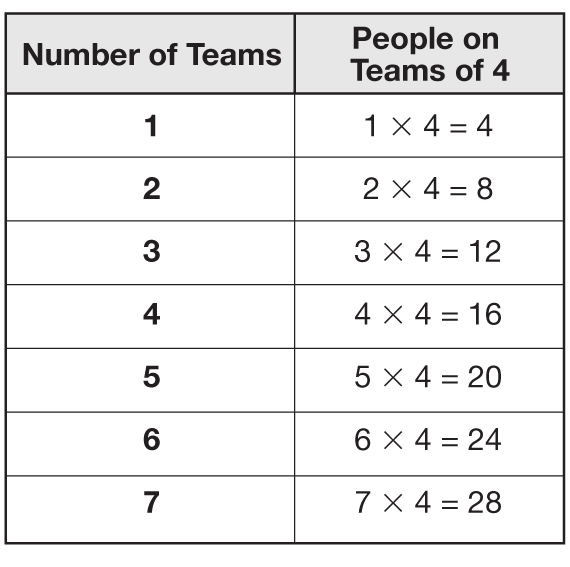Identify Multiples. Ask students to think about the number sentences they wrote in Lesson 4 Making Teams. Tell students that they are going to write number sentences to show how they would make teams of 4. Use the following prompts to guide the discussion. Record each of the number sentences suggested by students.
- What multiplication number sentence can you write to show 1 team of 4? (1 team × 4 people = 4 people)
- What number sentence can you write to show 2 teams of 4? (2 teams × 4 people = 8 people)
- What if we want to write a number sentence to show 3 teams of 4? (3 × 4 = 12) 4 teams of 4? (4 × 4 = 16)
Continue asking students for the number sentence that shows 5 teams of 4, 6 teams of 4, and 7 teams of 4. A complete list of number sentences for teams of 4 is shown in Figure 1.
- What are the products for each of the multiplication sentences you wrote? (4, 8, 12, 16, 20, 24, 28)
Explain that these numbers are multiples of the number 4 because a multiple of a whole number is the product of that number (in this case 4) multiplied by another whole number. A number is a multiple of another number if it is evenly divisible by that number (e.g., 12 is a multiple of 2 since 2 divides 12 evenly).
Continue this discussion by asking:
- What would happen if you started with 22 and tried to make equal teams of 4? (You would have 5 teams with 2 left over.)
- How can this help you decide if 22 is a multiple of 4? (22 can't be a multiple of 4 because you can't multiply another whole number times 4 to get 22 or 22 can't be divided into groups of 4 without leftovers.)
Skip Count to Find Multiples. You can find multiples of a number by skip counting. Display 3, 6, 9, and 12 and explain that these are the first four multiples of 3.
- Use skip counting to find the next four multiples of 3. (15, 18, 21, 24)
- What multiplication number sentence can you use to show 18 is a multiple of 3? (6 × 3 = 18 or 3 × 6 = 18)
- What multiplication number sentence can you use to show 24 is a multiple of 3? (8 × 3 = 24 or 3 × 8 = 24)
- How can you use skip counting to show that 30 is a multiple of 3? (If you keep skip counting, the next number you will get is 27 and then 30, so 30 is a multiple of 3.)
- What multiplication number sentence can you use to show 30 is a multiple of 3? (I used my fingers to keep track of the skips. 3, 6, 9, 12, 15, 18, 21, 24, 27, 30. There are 10 skips. 3 × 10 = 30.)
- How can you tell that 26 is not a multiple of 3? (If you skip count by 3s you don't say 26, and if you try to arrange 26 in groups of 3, you will have 8 groups with 2 left over.)
Ask students to think about skip counting by 2s as they answer the following questions:
- Is 4 a multiple of 2? (Yes.) How do you know? (4 = 2 × 2; 4 is a number you say when you skip count by 2s. 4 can be divided evenly into groups of 2.)
- Is 6 a multiple of 2? How do you know? (Yes, since 6 = 2 × 3. You say 6 when you skip count by 2s.)
- Is 8 a multiple of 2? How do you know? (Yes, since 8 = 2 × 4. If you skip count by 2s, you land on 8: 2, 4, 6, 8. I can divide 8 into groups of 2 evenly.)
- Is 20 a multiple of 2? How do you know? (Yes, since 20 = 2 × 10. I can divide 20 evenly into 10 groups of 2.)
- What do we call numbers that are multiples of 2? (even numbers)
- How do you know 17 is not a multiple of 2? (When you skip count by 2s, you do not say 17. 17 is not an even number. You can't multiply 2 by a whole number to get 17. I cannot divide 17 evenly into groups of 2.)

This lesson is an introduction to an ongoing exploration of multiples using the calendar. A new factor will be introduced each month. Students will begin this year-long exploration by identifying the multiples of 2 for the current month. If you begin by finding the multiples of 2 in September, students will explore the multiples of 2 through 11 by June. Figure 2 is an example of a completed calendar identifying the multiples of 3 in October.
Find Multiples on the Calendar. Ask students to turn to the Multiples on the Calendar pages in the Student Guide. Read the vignette to introduce finding multiples on a calendar. In this vignette, Tara's group identifies September 18 as today's date, and since it is a multiple of 2, Tara circles it on the calendar. Ask students to work with a partner to answer Questions 1–4.
Question 1 asks students to describe strategies Tara could use to show 18 is a multiple of 2. Strategies might include drawing a picture, forming groups of 2, repeated addition, or skip counting by 2s to show that 18 is a multiple of 2. Other students may recognize that 2 times 9 is equal to 18. Question 2 asks students to identify the number sentence Tara should write on the calendar. Students may suggest a number sentence using repeated addition, for example, 9 + 9 or 2 + 2 + 2 + 2 + 2 + 2 + 2 + 2 + 2. If these sentences are suggested as a solution, display the sentence and then ask if there is a way to represent their thinking in a multiplication number sentence. Questions 3–4 ask students to show or tell how they know whether 17 is a multiple of 2 and to complete a number sentence that includes both multiplication and addition.

When you multiply any number by zero the product will always be zero. This means that zero can be identified as a multiple of any number. However, multiples are usually listed starting with a specific factor without including zero. For example, the multiples of 4 are listed as 4, 8, 12, 16, etc.
Focus on Today's Date. Show students the large monthly calendar you prepared. Draw students' attention to today's date. Ask students to decide if the date is a multiple of 2 and to be prepared to show how they know if the date is a multiple of 2. Circulate while students are working and encourage students to use multiple methods or representations to show how they know if the date is a multiple of 2. Ask students to share the strategies they used to decide if the date is a multiple of 2. The dates of September 20 and September 21 are used as examples in the following discussion prompts.
- Who would like to show how they used a picture to help them decide if [September 20] is a multiple of 2? (See Figure 3.)
- Who would like to show how they used skip counting to decide if [September 20] is a multiple of 2? (When I skip counted by 2, I landed on 20. 2, 4, 6, 8, 10, 12, 14, 16, 18, 20. That is 10 skips. 2 × 10 = 20 or When I skip counted I did not land on 21. Ten skips get me to 20 and then one more step to 21. 21 is not a multiple of 2.)
- How does knowing that 20 is an even number help you decide if it is a multiple of 2? (All even numbers are multiples of 2.)
- What multiplication number sentence can we write to show today's date? (If today's date is a multiple of 2, the number sentence will use 2 as one of the factors, and the product will be the date. For example, if the date is September 20, possible responses include 2 × 10 = 20; 10 × 2 = 20; 20 = 2 × 10; or 20 = 10 × 2. If today's date is not a multiple of 2, number sentences will include both multiplication and addition. For example, September 21 can be expressed as 2 × 10 + 1 = 21; 10 × 2 + 1 = 21; 21 = 2 × 10 + 1; or 21 = 10 × 2 + 1. )
- I decided to write 9 × 2 + 3 = 21. How can this number sentence help me decide if 21 is a multiple of 2? (There are more than 2 left over, so 21 cannot be a multiple of 2. The 3 shows one more group of 2 and 1 left over.)
- I decided to write 9 × 2 + 2 = 20. How can this number sentence help me decide if 20 is a multiple of 2? (There are only 2 leftovers, so 20 is a multiple. There are really 10 groups of 2 in 20, so there are not any leftovers.)
- I decided to write 8 × 2 + 4 = 20. How can this number sentence help me decide if 20 is a multiple of 2? (4 is a multiple of 2, so there really are not any leftover groups of 2.)
- I decided to write 10 × 2 + 1 = 21. How can this number sentence help me decide if 21 is a multiple of 2? (This is probably the most obvious number sentence. This number sentence shows all 10 groups of 2 and that there is 1 left over.)
If today's date is a multiple of 2, circle it on the large monthly calendar.
Consider Other Dates. After discussing today's date, ask students to consider the days of the month that have already passed. Work together to record the number sentences on the class calendar and circle those dates that are multiples of 2. Ask students how the date can be displayed using a number sentence with the factor of the month. The factor of the month should indicate “how many” in each group as students determine how many groups should be formed for each date.
As you begin writing number sentences for the previous dates, students may be challenged by the dates that are smaller than the factor you are using to identify multiples. For example, students may not know how to write a number sentence for September 1 when they are identifying multiples of 2.
- Look at the date September 1. How many groups of 2 can be made? (0)
- How can we show this in a number sentence? (0 groups × 2 + 1 = 1)
- I decided to write 1 × 2 − 1 = 1. Does this help me decide if the number is a multiple? (It is mathematically correct, and it sort of shows that one group of 2 cannot be made, but the pattern is very different, and it is more difficult to see the leftovers.)
After completing the number sentences for all of the previous dates, let students know that this routine will be continued on the next day of class.
Ask students to open to the Multiples on the Calendar pages in their Student Guide. Read the directions for Check-In: Questions 5–10 before assigning the questions to students to complete independently.
Check-In: Questions 5–10 can be used to assess students' abilities to complete open number sentences involving multiplication [E1] and to represent multiplication problems in drawings [E2].
Although it may be helpful to introduce this activity using counters, it may not be convenient to use manipulatives every day. As the activity progresses, use pictures to help students with the multiplication sentences. For example, if the factor for January is 6, students can draw 20 Xs to show January 20. See Figure 4.




















